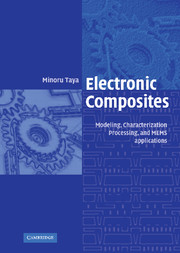Book contents
- Frontmatter
- Contents
- Preface
- Acknowledgements
- 1 Introduction
- 2 Applications of electronic composites
- 3 Foundations of modeling
- 4 Models for electronic composites based on effective medium theory
- 5 Resistor network model for electrical and thermal conduction problems
- 6 Percolation model
- 7 Lamination model
- 8 Engineering problems
- Appendix A Eshelby tensors
- Appendix B Physical constants and properties of materials
- References
- Author index
- Subject index
2 - Applications of electronic composites
Published online by Cambridge University Press: 03 May 2011
- Frontmatter
- Contents
- Preface
- Acknowledgements
- 1 Introduction
- 2 Applications of electronic composites
- 3 Foundations of modeling
- 4 Models for electronic composites based on effective medium theory
- 5 Resistor network model for electrical and thermal conduction problems
- 6 Percolation model
- 7 Lamination model
- 8 Engineering problems
- Appendix A Eshelby tensors
- Appendix B Physical constants and properties of materials
- References
- Author index
- Subject index
Summary
We shall review applications of electronic composites in this chapter, which is subdivided into four areas: electronic packaging, MEMS, composites for sensors and actuators, and control of electromagnetic waves.
Electronic packaging
Electronic composites have been used extensively for electronic packaging materials, which often have conflicting requirements that are difficult to meet – high thermal conductivity, low electrical conductivity, and low coefficient of thermal expansion (CTE). In addition, low density and low cost are normally required, particularly for commercial packaging applications. Thus polymer matrix composites are the most popular choice, while some military and space applications require the use of high-performance electronic composites, thus sometimes justifying the use of metal matrix composites and ceramic matrix composites. A detailed review of electronic packaging materials is summarized in a book by Chung (1995). Zweben (1995) made an extensive review of electronic composites for use in electronic packaging, which include all types of composites, polymer matrix composites (PMCs), metal matrix composites (MMCs), ceramic matrix composites (CMCs) and carbon/carbon (C/C) composites.
Applications of electronic composites are quite extensive, covering computers, appliances, generators, and transformers, to name a few. Depending on their physical functions, one can categorize them into several types – housing, insulator, resistor, and conductor – which are discussed below. It is to be noted here that the housing material can be an insulator, a conductor, or an electromagnetic wave absorber, depending on the specific application.
- Type
- Chapter
- Information
- Electronic CompositesModeling, Characterization, Processing, and MEMS Applications, pp. 19 - 68Publisher: Cambridge University PressPrint publication year: 2005
- 1
- Cited by



